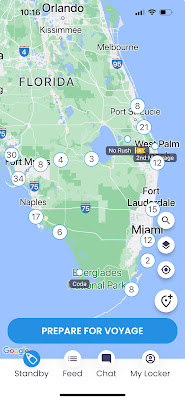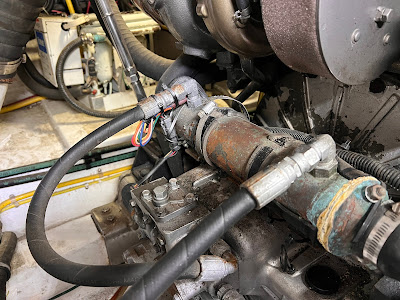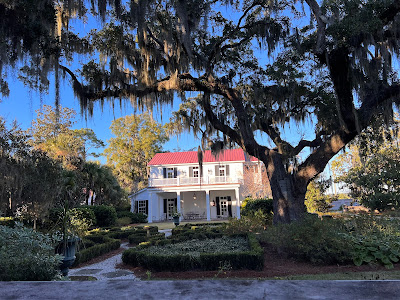 |
| My sister Jeanne captured Mike and me in the final stages of applying the new boat name. |
New Boat Name
Finally, I’m revealing the boat name to all of you. It took probably 16 hours of unpeeling, scraping, rubbing, and polishing with a power tool to get 95% of the old lettering off. When it seemed that only a new gel coat via a professional could do better, Mike halted.
We got as far south as Palm Coast, FL, when my sister Jeanne visited us for four days. Thank goodness Jeanne was there to help.
About halfway into the application, it starts to sprinkle unexpectedly. We became nervous because rain on the fiberglass while applying lettering was a no-go. We were reminded that a little sprinkle quickly turns into a heavy shower in the Southeast. We grabbed large trash bags, cut them open, and draped them over the taped-on lettering. We finished in the nick of time because it rained steadily for about 30 minutes. After we were certain that the rain stopped, and the ground dried a bit, we continued the careful process of applying the letters.
 |
| Jeanne and Mike were on a roll. The unexpected rain halted all work. |
We just love the font and large size of the letters. It was a proud moment to see our handiwork. Now the boat felt like our own. Our own home, that is.
 |
| Introducing: “Sacagawea.” From the home port of Seattle, WA(1). Jeanne waved goodbye as she snapped this pic. We left her and headed South to Daytona Beach. |
We evoked Sacagawea because we think of our boat as a female guide.(2) We are also nodding to the first people who populated the waterways. We are learning a lot about the first people, European colonists, slavery, and American history in the towns we visit. Remembering the first people helps us keep history in context.
Mike was thinking about other places and ways that the old name surfaces. For example, Elizabeth Ann II is our AIS name. It may take a technician from the radio company to come to the boat to rename it. Once we change all the places and things with the old name we will break a bottle of champagne to appease the gods.
An Encounter
At each destination, we've been planning the next two stops on our journey south for the winter. At Jekyll Island, we saw that there were two series of strong wind days forecasted for later in the week. We continued South on a windy, but manageable to navigate, day to Fernandina Island.
After checking the forecast later in the day, we asked the marina to mark us down for two days longer than planned. Our inside, side-tie slip was fortuitous. There was a wide, concrete floating dock between us and the ICW channel.
On the first day, just as we were tending to errands we had a happy encounter. A couple of kindly brothers came down to our dock and introduced themselves. They saw our AGLCA burgee via the Nebo app and wanted to see how things were going. One of them just finished the loop and just on a whim decided to check Nebo to see if any Loopers were nearby. After a pleasant chat in our saloon, they offered to drive us anywhere. We took them up on it and I went to Publix grocery store while Mike made a stop at an auto parts store for an orbital polisher (to rid the boat of the remainder of the old name).
 |
| This is a screenshot of Nebo. It shows the location of people who use the Nebo app. It's interesting to see where the bulk of Loopers are at his time of year. Most are in the Ft. Myers area. |
Would you have accepted their kind offer? I hesitated. We couldn't reciprocate. We all admitted this and said we would pay it forward. I hope I can be more accepting of generosity going forward. Offering to help is a warm, distinguishing feature of the boating community. I want to project this warmth as well.
Tornado Warning
Two mornings after our encounter we were preparing for the forecasted strong winds. We added two lines for a total of six lines attaching Sacagawea to the dock. I wanted to take advantage of downtime to get my haircut and research marinas. Mike was cleaning the bilge.
That's when I learned from the hair salon that businesses were closing early that day due to high winds. Within an hour I received an alert on my phone that our county was under tornado watch. We made a quick plan: leave our chore list behind, don our wet gear, and with our domino set and lunch in a backpack, go hang out in the “captain’s lounge” at the marina. After one domino game, the warning was extended a few hours longer. We headed to a new, more secure place--the hotel lobby across the street. At this point, it was a little rainy and windy with low clouds. We noticed the wind across our face was blowing in a different direction than the way the angry clouds were moving.
So we played another game. Mike struck up a friendly conversation with an 89-year-old woman from Kentucky who was also storm-watching in the lobby. She also had never been in a tornado watch situation. She wanted to hear more about our Loop plans. People are so interested in our plans!
After a couple of hours we felt that we were wearing out our welcome at the hotel. We went to a charming wine bar a couple of blocks away that's nestled in a strong brick building. Behold, they were open! We played a third round. Mike chatted on the phone with a couple of friends.
 |
| A cozy and safe locale during the tornado warning, a wine bar. |
By about 6:00 pm the tornado warning abated and we returned to the boat. It was still a little rainy and windy. We were pleased to see Sacagawea’s lines and fenders were solid.
Even though tornadoes were not seen in our vicinity, the danger was not over. A strong wind was forecast overnight. As it turned out, I slept great that night. We didn't experience any dramatic rock and roll. Mike, however, did get up at 1:00 am and stepped outside to look at 3-4 foot waves slapping the dock. (See his video of this below.) The next morning some sailors on the windward side told Mike it was their worst night ever on their boat.
It was a good lesson for us. We will continue to seek out inside positions on docks when there's a high wind in the forecast.
Tourist Mecca
I now return to our town visits. We saw a lot of beautiful historic homes and modern American history!
Before Jeanne joined us we stopped at Jekyll Island.
We haven't tired of seeing the swaying Spanish Moss. Ghostly. Graceful.
After the bad weather, we returned to St. Augustine for one night. We eagerly picked up about 10 Amazon packages we shipped to us at St. Augustine.
 |
| Entering the drawbridge of Castillo de San Marco Fort at St.Augustine. |
When Jeanne joined we took advantage of her rental car and re-visited the fort at St. Augustine. The changing uses of the fort reflect the changes in Florida.
The following day we spent 8 hours at the interesting, inspiring, and grand Kennedy Space Center.
 |
| The 122-foot-long Atlantis space shuttle. It was hung impressively at an angle along a walkway so that we could admire the construction above and below as well as see the open interior. |
 |
| ...and the bottom of The Atlantis. This endured 33 missions. |
Landlubbing
We had been slow to find a reputable and convenient boat yard to complete the hull repaint, stabilizer fiberglass work, and some gel coat cracks. On our last full day with Jeanne, I called a well-regarded boatyard in the next destination south, Daytona Beach. Their prices were reasonable and, shocker, they had availability the next day. However, the work would take about a week and we would not be able to stay on the boat, our “house,” so we got to take up an open invitation from our friends, Meredith & John, in Naples, Florida. With one day's notice, they received us with open arms. (Thanks, guys!) We rented a car and booked over to the Gulf side of Florida.
 |
| At the beach before a fancy Naples, FL, restaurant meal with our hosts Meredith and John. |
Our plans now are to find a marina that's reasonably priced in the greater Ft. Lauderdale area. We’ll stay there for perhaps a month. Then we will start The Loop, so to speak, by heading North at the end of the winter.
Footnotes for Fun Fact Fans
(1) Sacagawea is a Coast Guard documented vessel. This requires us to have a name and a port clearly written on the vessel. Even though we don't technically live in Seattle we decided to use the name because it’s the best known city in Washington state, where we have state residency. The port name on the boat has nothing to do with boat taxes. We could have used any town in the United States.
(2) After some Internet research we learned that there are many retellings and mysteries surrounding Sacagawea’s life. There are multiple ways of spelling her name in English using our alphabet. We think it's appropriate to just remember her and learn what we can of her.
(3) The Turtle Center was a highlight for me. I learned that all the turtles in the Jekyll Island area are at least endangered. Don't forget that turtles on shore get confused by our nighttime lights and can disrupt where they wander--their safety and breeding.


























